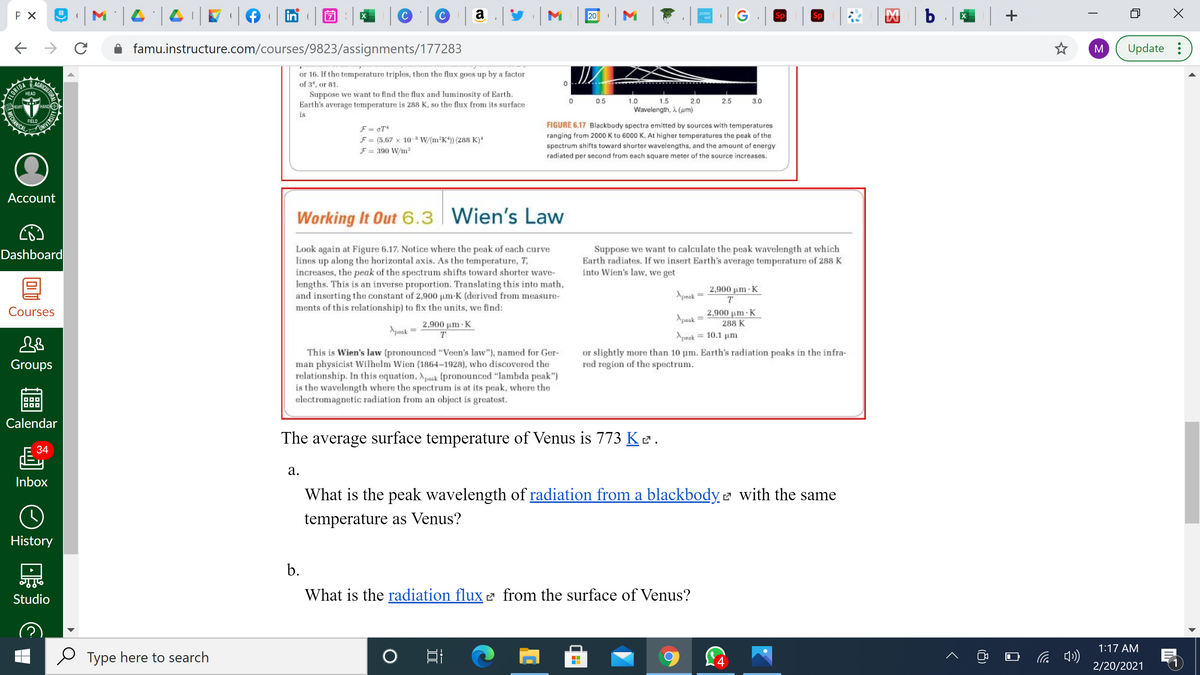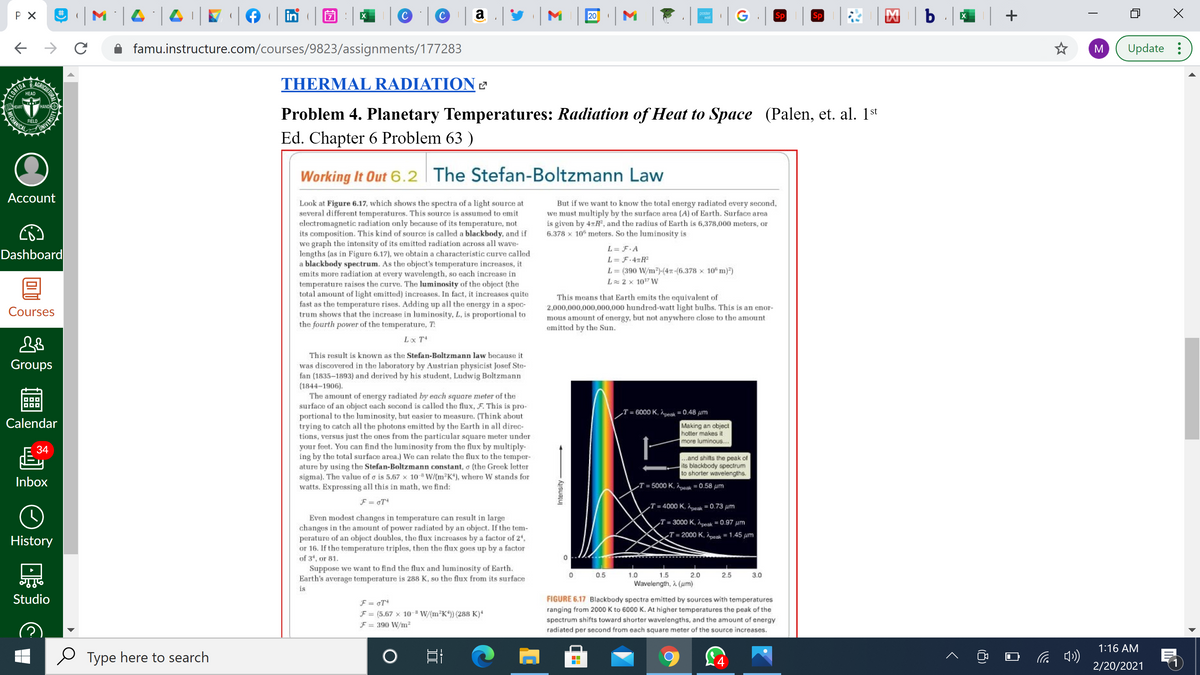Working It Out 6.3 Wien's Law Look again at Figure 6.17. Notice where the peak of each curve lines up along the horizontal axis. As the temperature, T, increases, the peak of the spectrum shifts toward shorter wave- lengths. This is an inverse proportion. Translating this into math, and inserting the constant of 2,900 um-K (derived from measure- ments of this relationship) to fix the units, we find: Suppose we want to calculate the peak wavelength at which Earth radiates. If we insert Earth's average temperature of 288 K into Wien's law, we get 2,900 pm -K 2.900 um-K 288 K 2,900 pum - K A 10.1 pum This is Wien's law (pronounced "Voen's law"), named for Ger- man physicist Wilhelm Wien (1864-1928), who discovered the relationship. In this equation, Xyusa (pronounced "lambda peak") is the wavelength where the spectrum is at its peak, where the electromagnetic radiation from an object is greatest. or slightly more than 10 pm. Earth's radiation peaks in the infra- red region of the spectrum. The average surface temperature of Venus is 773 Ke.
Working It Out 6.3 Wien's Law Look again at Figure 6.17. Notice where the peak of each curve lines up along the horizontal axis. As the temperature, T, increases, the peak of the spectrum shifts toward shorter wave- lengths. This is an inverse proportion. Translating this into math, and inserting the constant of 2,900 um-K (derived from measure- ments of this relationship) to fix the units, we find: Suppose we want to calculate the peak wavelength at which Earth radiates. If we insert Earth's average temperature of 288 K into Wien's law, we get 2,900 pm -K 2.900 um-K 288 K 2,900 pum - K A 10.1 pum This is Wien's law (pronounced "Voen's law"), named for Ger- man physicist Wilhelm Wien (1864-1928), who discovered the relationship. In this equation, Xyusa (pronounced "lambda peak") is the wavelength where the spectrum is at its peak, where the electromagnetic radiation from an object is greatest. or slightly more than 10 pm. Earth's radiation peaks in the infra- red region of the spectrum. The average surface temperature of Venus is 773 Ke.
College Physics
10th Edition
ISBN:9781285737027
Author:Raymond A. Serway, Chris Vuille
Publisher:Raymond A. Serway, Chris Vuille
Chapter12: The Laws Of Thermodynamics
Section: Chapter Questions
Problem 28P: Suppose the Universe is considered to be an ideal gas of hydrogen atoms expanding adiabatically. (a)...
Related questions
Question
100%

Transcribed Image Text:P X
%23
in
a
20
poster
wll
Sp
Sp
famu.instructure.com/courses/9823/assignments/177283
M
Update :
or 16. If the temperature triples, then the flux goes up by a factor
of 34, or 81.
FLORIDA
MECHANICAL
AGRICULTURA
HEAD
Suppose we want to find the flux and luminosity of Earth.
Earth's average temperature is 288 K, so the flux from its surface
0.5
1.0
1.5
2.0
2.5
3.0
HEART
HAND
Wavelength, i (um)
is
FIELD
FIGURE 6.17 Blackbody spectra emitted by sources with temperatures
F = oT*
F = (5.67 x 10- W/(m²K*)) (288 K)*
F = 390 W/m?
ranging from 2000 K to 6000 K. At higher temperatures the peak of the
spectrum shifts toward shorter wavelengths, and the amount of energy
radiated per second from each square meter of the source increases.
Account
Working It Out 6.3 Wien's Law
Look again at Figure 6.17. Notice where the peak of each curve
lines up along the horizontal axis. As the temperature, T,
increases, the peak of the spectrum shifts toward shorter wave-
lengths. This is an inverse proportion. Translating this into math,
and inserting the constant of 2,900 pm-K (derived from measure-
ments of this relationship) to fix the units, we find:
Suppose we want to calculate the peak wavelength at which
Earth radiates. If we insert Earth's average temperature of 288 K
into Wien's law, we get
Dashboard
Apeak
2,900 um K
T.
%3D
Courses
2,900 um K
Apaak
2,900 pm K
288 K
Apask
Apaak
= 10.1 pm
or slightly more than 10 um. Earth's radiation peaks in the infra-
red region of the spectrum.
This is Wien's law (pronounced "Veen's law"), named for Ger-
man physicist Wilhelm Wien (1864-1928), who discovered the
relationship. In this equation, Xpask (pronounced "lambda peak")
is the wavelength where the spectrum is at its peak, where the
electromagnetic radiation from an object is greatest.
Groups
Calendar
The average surface temperature of Venus is 773 Ke.
34
а.
Inbox
What is the peak wavelength of radiation from a blackbody e with the same
temperature as Venus?
History
b.
Studio
What is the radiation flux 2 from the surface of Venus?
1:17 AM
e Type here to search
4
2/20/2021
|
+
(3)
II
UNIVERSITY

Transcribed Image Text:P X
%23
in
a
20
poster
wal
Sp
Sp
famu.instructure.com/courses/9823/assignments/177283
M
Update :
THERMAL RADIATION 2
FLORIDA
MECHANICAL
AGRICULTURA
HEAD
HEART
HAND
Problem 4. Planetary Temperatures: Radiation of Heat to Space (Palen, et. al. 1st
Ed. Chapter 6 Problem 63 )
FIELD
Working It Out 6.2 The Stefan-Boltzmann Law
Account
Look at Figure 6.17, which shows the spectra of a light source at
several different temperatures. This source is assumed to emit
electromagnetic radiation only because of its temperature, not
its composition. This kind of source is called a blackbody, and if
we graph the intensity of its emitted radiation across all wave-
lengths (as in Figure 6.17), we obtain a characteristic curve called
a blackbody spectrum. As the object's temperature increases, it
emits more radiation at every wavelength, so each increase in
temperature raises the curve. The luminosity of the object (the
total amount of light emitted) increases. In fact, it increases quite
fast as the temperature rises. Adding up all the energy in a spec-
trum shows that the increase in luminosity, L, is proportional to
the fourth power of the temperature, T
But if we want to know the total energy radiated every second,
we must multiply by the surface area (A) of Earth. Surface area
is given by 4xR, and the radius of Earth is 6,378,000 meters, or
6.378 x 10° meters. So the luminosity is
L= F.A
Dashboard
L= F.4nR
L= (390 W/m")-(4T-(6.378 x 10" m)7)
L 2 x 1017 W
This means that Earth emits the equivalent of
2,000,000,000,000,000 hundred-watt light bulbs. This is an enor-
mous amount of energy, but not anywhere close to the amount
emitted by the Sun.
Courses
Lx T+
This result is known as the Stefan-Boltzmann law because it
Groups
was discovered in the laboratory by Austrian physicist Josef Ste-
fan (1835–1893) and derived by his student, Ludwig Boltzmann
(1844-1906).
The amount of energy radiated by each square meter of the
surface of an object each second is called the flux, F. This is pro-
portional to the luminosity, but easier to measure. (Think about
trying to catch all the photons emitted by the Earth in all direc-
tions, versus just the ones from the particular square meter under
your feet. You can find the luminosity from the flux by multiply-
ing by the total surface area.) We can relate the flux to the temper-
ature by using the Stefan-Boltzmann constant, o (the Greek letter
sigma). The value of o is 5.67 x 1o W/(m2K*), where W stands for
watts. Expressing all this in math, we find:
T = 6000 K, peak =0.48 um
Calendar
Making an object
hotter makes it
more luminous...
34
...and shifts the peak of
its blackbody spectrum
to shorter wavelengths.
Inbox
T 5000 K, Apaak =0.58 um
F = oT*
T = 4000 K, k =0.73 um
Even modest changes in temperature can result in large
changes in the amount of power radiated by an object. If the tem-
perature of an object doubles, the flux increases by a factor of 24,
or 16. If the temperature triples, then the flux goes up by a factor
of 3*, or 81.
T = 3000 K, Aeak = 0.97 um
-T = 2000 K, peak =1.45 um
History
Suppose we want to find the flux and luminosity of Earth.
Earth's average temperature is 288 K, so the flux from its surface
0.5
1.0
1.5
2.0
2.5
3.0
Wavelength, i (um)
is
Studio
FIGURE 6.17 Blackbody spectra emitted by sources with temperatures
F = oT
F = (5.67 x 10- W/(m²K*)) (288 K)*
F = 390 W/m?
ranging from 2000 K to 6000 K. At higher temperatures the peak of the
spectrum shifts toward shorter wavelengths, and the amount of energy
radiated per second from each square meter of the source increases.
1:16 AM
e Type here to search
日i
4
2/20/2021
|
+
(3)
Intensity
UNIVERSITY
Expert Solution
This question has been solved!
Explore an expertly crafted, step-by-step solution for a thorough understanding of key concepts.
This is a popular solution!
Trending now
This is a popular solution!
Step by step
Solved in 3 steps with 3 images

Knowledge Booster
Learn more about
Need a deep-dive on the concept behind this application? Look no further. Learn more about this topic, physics and related others by exploring similar questions and additional content below.Recommended textbooks for you

College Physics
Physics
ISBN:
9781285737027
Author:
Raymond A. Serway, Chris Vuille
Publisher:
Cengage Learning


College Physics
Physics
ISBN:
9781938168000
Author:
Paul Peter Urone, Roger Hinrichs
Publisher:
OpenStax College

College Physics
Physics
ISBN:
9781285737027
Author:
Raymond A. Serway, Chris Vuille
Publisher:
Cengage Learning


College Physics
Physics
ISBN:
9781938168000
Author:
Paul Peter Urone, Roger Hinrichs
Publisher:
OpenStax College

Foundations of Astronomy (MindTap Course List)
Physics
ISBN:
9781337399920
Author:
Michael A. Seeds, Dana Backman
Publisher:
Cengage Learning

Stars and Galaxies (MindTap Course List)
Physics
ISBN:
9781337399944
Author:
Michael A. Seeds
Publisher:
Cengage Learning

Horizons: Exploring the Universe (MindTap Course …
Physics
ISBN:
9781305960961
Author:
Michael A. Seeds, Dana Backman
Publisher:
Cengage Learning